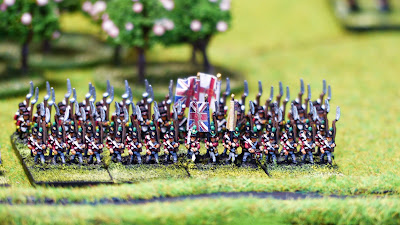To complement my British Peninsular units I am mustering some Spanish and Portuguese units. Actually, the word 'some' is a bit of a misnomer since the unpainted lead I got recently from Baccus is anything but ! Anyway, this week I got eight Spanish infantry stands off the painting desk, just shy of a hundred figures, representing the 7th 'Zamora' line regiment with black facings and the 8th 'Soria' regiment with purple facings. I am not aiming for any particular historical scenario so I am choosing units at my whim. Unfortunately Spanish army organisation was quite chaotic between 1805 and 1812 and OOB's are rarely complete and accurate so it is quite useless to invest too much time in researching in too much detail as very often there is none to be found ! I am mostly using Steven Thomas's excellent site at https://balagan.info which contains a wealth of information on Spanish army uniforms and organisation during the French invasion and the Peninsular War.
As usual, units are based for Age of Eagles on bases 3/4"frontage by 1" depth with twelve figures to a stand. Baccus come in strips of four so they fit in almost exactly to one base frontage.
There were nominally three battalions per regiment in 1808 but there was no such thing in real life and no more than two would actually see the field. The first battalion would have two grenadier companies which would sometimes be hived off (as per the Austrian model) into separate units and the rest of the battalion would then join other fusilier units orphaned of their grenadiers into ad hoc formations. To mirror this as much as I could I put one stand of grenadiers for every three of fusiliers - this should give me the ability to muster the grenadier stands separately if necessary. The figures shown wear the 1802 / 1805 model uniform with bicornes and white jackets in regimental facing colours while drummers wear blue jackets piped in red. Officers carry a crimson sash, presumably to impress the senoritas !
Apart from the regular units there was a plethora of irregular militia and guerilla units, mostly in civilian clothes or brown jackets. Information on such units is sparse, however, and honestly it is doubtful how useful such units would be on the wargames table so I am not sure if it is worth going into much depth in this area.
 |
| Units in line - 'Zamora' to left and 'Soria' to right |
 |
| Units in Supported Line - 'Soria' in front and 'Zamora' to the rear |
 | |
| Each regiment carried a king's colour (foreground) together with battalion / regimental flags |








